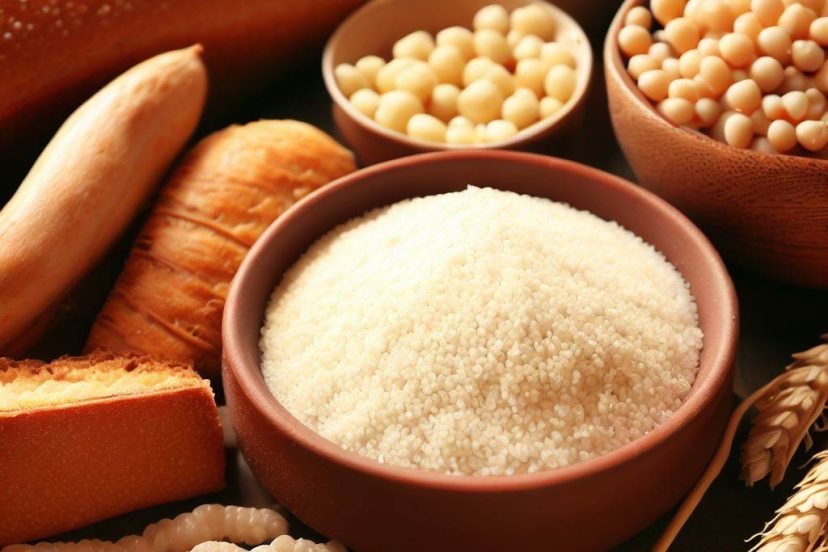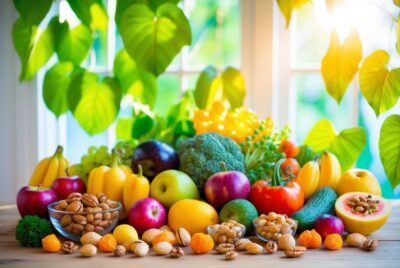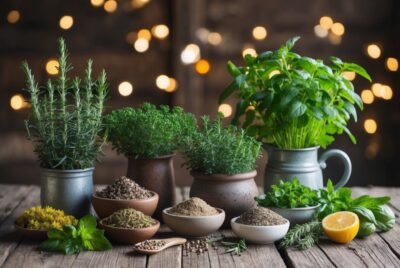Gluten Free Carbs: Your Diet Guide
*We may earn a commission for purchases made using our links. Please see our disclosure to learn more.
Gluten Free Carbs: Your Guide to Safe and Healthy Options
The long overdue guide on Gluten Free Carbs is here! Choosing the right carbohydrates is crucial when following a gluten-free diet. Gluten, a protein found in wheat, barley, and rye, is off-limits for individuals with celiac disease, non-celiac gluten sensitivity, or gluten intolerance. The absence of gluten in the diet necessitates alternative sources of carbs which do not compromise on energy or nutritional value. Numerous naturally gluten-free options such as starchy vegetables, fruits, and whole grains, like quinoa and rice, fit the bill providing both the necessary fuel for the body and a variety of health benefits.
I understand that finding gluten-free carb sources might seem challenging at first. However, I’ve learned that the range of suitable alternatives is broader than most initially assume. For example, legumes, as well as certain tubers like potatoes and sweet potatoes, offer a wealth of gluten free carbohydrates along with dietary fiber and protein, making them ideal for a balanced and satisfying diet. Embracing these naturally gluten-free staples can lead to a diverse and enjoyable meal plan, rich in complex carbohydrates that are essential for sustained energy throughout the day.
While managing a gluten-free diet, I focus on unprocessed, whole food carbohydrate sources that minimize risks of cross-contamination with gluten-containing grains. It’s rewarding to discover and integrate gluten-fee flours such as those made from rice, soy, corn, potato, and beans into my cooking and baking to keep meals varied and wholesome. Additionally, I stay informed about product labels and certifications to ensure that even packaged gluten-free foods align with my dietary needs.
Understanding Gluten and Its Sources

In this section, I will detail the function of gluten in foods and delineate the primary sources where gluten can be found.
The Role of Gluten in Foods
Gluten is a protein composite that endows certain foods with desirable qualities. In grains such as wheat, barley, and rye, it gives elasticity to the dough, allowing it to rise and maintain its shape, as well as providing a chewy texture. Gluten is essential for the structure of many baked goods.
- Wheat: The most common source of gluten, important in breads, pastas, and pastries.
- Barley: Used in malt products and as an agent in food coloring and soups.
- Rye: Found in rye bread, cereals, and beer.
Common Sources of Gluten
Being informed about where gluten is present can help either with the avoidance for those with sensitivities or the leverage of its qualities for baking and cooking. Below, I’ve included lists of gluten-containing grains, and common foods where gluten is typically found:
Grains Containing Gluten:
- Wheat (includes varieties like spelt, kamut, farro, and durum; also found as wheatberries)
- Barley (may appear as malt, malted barley flour, malt extract, or malt vinegar)
- Rye
- Triticale (a hybrid of wheat and rye)
Common Foods with Gluten:
- Breads and baked goods
- Pasta
- Cereals
- Snack foods
- Sauces and gravies
It’s important to note that a wheat allergy is different from gluten sensitivity, as it involves an immune response specifically to wheat proteins, not just the gluten contained within it. Therefore, avoiding only wheat is imperative for those with a wheat allergy, but for someone with celiac disease or non-celiac gluten sensitivity, all sources of gluten must be avoided.
Health Implications of Gluten

In this section, I will discuss the varying health concerns related to gluten consumption, which can range from severe autoimmune reactions to less pronounced sensitivities. The emphasis on gluten-related disorders has led many to adopt a gluten-free diet, which for some is not a choice but a necessity for maintaining health.
Celiac Disease Explained
Celiac disease is an autoimmune disorder in which the ingestion of gluten leads to damage in the small intestine. When I consume gluten, my body mounts an immune response that attacks the villi, the tiny fingerlike projections lining my small intestine, which are crucial for nutrient absorption. Symptoms of celiac disease can include weight loss, bloating, and sometimes diarrhea or constipation. Adhering to a strict gluten-free diet is essential for individuals like me with celiac disease to prevent long-term health complications.
Gluten Allergy and Sensitivity
Then there is what’s called gluten allergy, which actually encompasses a range of conditions, including wheat allergy and non-celiac gluten sensitivity. If I have a gluten allergy, my body’s immune system reacts to proteins found in wheat and related grains. Non-celiac gluten sensitivity, on the other hand, doesn’t have the same immune response or intestinal damage found in celiac disease but can cause similar symptoms like stomach pain, bloating, and fatigue. Removal of gluten from my diet typically alleviates these symptoms.
Benefits of a Gluten-Free Diet
Transitioning to a gluten-free diet can offer notable benefits for individuals with gluten-related disorders. For those diagnosed with celiac disease or gluten sensitivity, switching to gluten-free sources of carbohydrates like amaranth, buckwheat, and corn can lead to improved gut health and an increase in energy levels. However, it’s important to avoid equating gluten-free with weight loss, as this is not inherently guaranteed and depends on my overall dietary choices and lifestyle.
Gluten-Free Carbohydrates

I understand the importance of including gluten-free carbohydrate sources in the diet for those with celiac disease or gluten sensitivity. These sources provide not only the necessary energy but also beneficial fiber. Here, I explore various gluten-free carbohydrates that fit into different categories, such as grains, vegetables, and legumes.
Naturally Gluten-Free Grains
Among grains, rice is a staple gluten-free carbohydrate; specifically, brown rice is rich in fiber and nutrients. Another excellent grain is quinoa, which I value for its complete protein profile and versatile use in recipes. I also recommend buckwheat and millet, which are not only gluten-free but also offer a robust nutrient profile with reasonable carbohydrate content. Lesser-known grains like amaranth and teff are also safe options, each bringing a unique texture and nutritional benefits, including high amounts of minerals and fiber.
| Grain | Benefit |
| Rice | Energy-rich |
| Quinoa | Complete protein |
| Buckwheat | Rich in minerals |
| Millet | High in fiber |
| Amaranth | Good mineral source |
| Teff | High in fiber |
Starchy Vegetables and Roots
I often turn to vegetables such as potatoes and sweet potatoes for their nutrient-dense carbohydrate content. These starchy vegetables are versatile in the kitchen and can be prepared in numerous ways while providing energy and fiber. Similarly, corn can be consumed as a whole grain or processed into cornmeal or corn flour, offering complex carbohydrates alongside essential vitamins and minerals.
Legumes and Seeds as Carb Sources
For those seeking gluten-free carbohydrates that also contribute significant amounts of protein and fiber, I suggest incorporating legumes into their diet. Beans and lentils are fantastic options that I use frequently because of their versatility and nutrient profile. They can be added to soups, salads, or main dishes, boosting the carbohydrate and protein content of meals efficiently. Seeds like quinoa (technically a seed despite being classified as a grain) also serve dual roles by providing carbohydrates and essential amino acids.
Gluten-Free Recipes and Cooking Tips
In this section, I’ll walk you through some trusted methods and essential tips for creating satisfying gluten-free meals and mastering gluten-free baking. By applying these principles, you can ensure your gluten-free cooking is both enjoyable and successful.
Creating Gluten-Free Meals
When preparing gluten-free meals, I focus on naturally gluten-free ingredients and look for ways to replace gluten-containing staples. Here are some specific carbohydrate options and tips for meal prep:
- Grains: Quinoa and rice are versatile and can serve as the base for a variety of dishes. Puffed rice cereal can be employed for breakfast options.
- Vegetables: Starchy vegetables like corn are excellent sources of gluten-free carbs. Corn can be found in several forms, such as homemade corn chips which pair wonderfully with a fresh mango salsa.
For pasta lovers, I’ve discovered that zucchini makes an excellent pasta substitute. You can spiralize it and top it with a lemon garlic shrimp for a refreshing twist on traditional pasta.
Cooking Tip: Always read labels carefully to ensure that your ingredients are certified gluten-free, especially when it comes to sauces and seasonings that may harbor hidden gluten.
Navigating Gluten-Free Baking
Avoiding gluten in baking isn’t as challenging as it may seem if you know the right substitutes:
- Gluten-Free Flours: Almond flour, coconut flour, and gluten-free oat flour are some of my go-to flours for baking. These can be used to make gluten-free bread and other baked goods.
- Baking Recipes: A homemade gluten-free bread recipe typically involves combining several gluten-free flours to mimic the texture of wheat bread. Gluten-free muffins, cookies, and cakes follow similar principles, often requiring xanthan gum to add the elasticity that gluten would otherwise provide.
For those who enjoy a sweet breakfast, rice flour pancakes offer a delightful alternative to traditional pancakes.
Baking Tip: Prevent cross-contamination in the kitchen by keeping gluten-free ingredients separate and using clean utensils. Moreover, always double-check your baking powder and other additives to ensure they do not contain gluten.
Navigating a Gluten-Free Lifestyle

When I first embarked on a gluten-free lifestyle, I realized the importance of thoroughly understanding food labels, vigilantly avoiding cross-contamination, and safely navigating dining out. These strategies have become the cornerstone of maintaining a gluten-safe diet.
Understanding Food Labels and Gluten Free Carbs
I have learned that identifying gluten-free products requires careful inspection of food labels. The FDA mandates that labels proclaiming “gluten-free” must contain less than 20 parts per million (ppm) of gluten. This includes products labeled “no gluten,” “free of gluten,” and “without gluten.” I make sure to look for these certifications, especially on products like oats, which can be contaminated with wheat during processing. Furthermore, items like ale, beer, and malt beverages typically contain gluten unless explicitly marked otherwise. Ingredients like sauces may hide sources of gluten, so I always double-check for phrases like “modified food starch,” which can be a red flag.
Avoiding Cross-Contamination with Gluten Free Carbs
In my own kitchen, I prevent cross-contamination by employing separate cooking tools and surfaces for gluten-free foods. For instance, I use different cutting boards for gluten-free and gluten-containing foods. I also store gluten-free products above wheat-based ones to avoid crumbs falling into them. I have found that it’s vital to use a clean toaster for gluten-free bread or to utilize toaster bags to avoid cross-contact.
When it comes to products that are naturally gluten-free but prone to cross-contamination, like oats, I purchase those that are specifically labeled gluten-free to ensure they are safe.
Gluten-Free Dining Out
Dining out requires clear communication and a bit of research. I start by checking menus ahead of time and look for restaurants that offer a gluten-free menu or have clearly marked gluten-free options. I always inform the server of my dietary needs and ask detailed questions about menu items. Toclarify how dishes are prepared to address any concerns regarding cross-contamination. It’s crucial to inquire whether items like soy sauce, marinades, or dressings contain gluten, as these can turn a seemingly safe dish into one that’s not suitable for a gluten-free diet. When in doubt, I stick to simple, less processed foods such as grilled meats and vegetables.
Adopting these practices has greatly improved my confidence in managing a gluten-free lifestyle both at home and when I’m out. My vigilance in these areas has become second nature, making it easier to lead a healthy and safe gluten-free life.
Frequently Asked Questions about Gluten Free Carbs
Navigating a gluten-free diet can be challenging, especially when it comes to finding the right carbohydrate sources. As someone with experience in this area, I aim to provide clear and specific answers to common concerns.
1. Which snack options are safe for someone with celiac disease?
For individuals with celiac disease, it’s essential to choose snacks that are certified gluten-free. Options like rice cakes, popcorn, and gluten-free pretzels are safe. Fruits and nuts are also naturally gluten-free and make for healthy snacking.
2. Can you suggest gluten-free carbohydrate sources suitable for breakfast?
A gluten-free breakfast can include carbohydrates such as rice, quinoa, or gluten-free oatmeal. You might also enjoy gluten-free pancakes or waffles made from rice or coconut flour, providing a satisfying start to the day.
3. What are some gluten-free carbohydrate-rich foods that athletes can include in their diet?
Athletes on a gluten-free diet can get their carbs from foods like sweet potatoes, quinoa, and rice. These foods offer the necessary energy without the gluten. Additionally, gluten-free pasta made from rice or corn is available for those needing a more substantial meal.
4. Are oats safe to consume on a gluten-free diet or do they contain gluten?
Pure oats are gluten-free and safe for most people with gluten intolerance, but contamination with gluten during processing is common. If including oats in your diet, ensure they are labeled as certified gluten-free to avoid accidental exposure to gluten.
5. How can one ensure they are selecting truly gluten-free snacks to avoid contamination?
I recommend choosing snacks labeled as certified gluten-free to avoid contamination. You should also be cautious of products processed in facilities that handle gluten-containing foods, because cross-contamination is possible.




